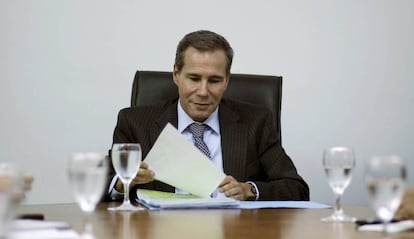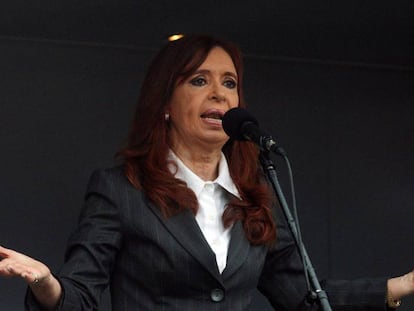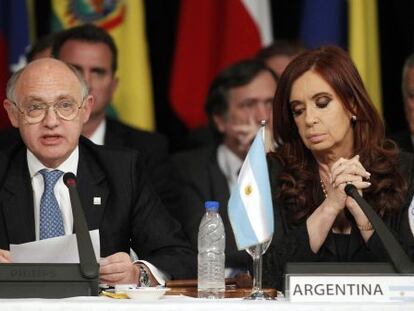Two years on, death of Argentinean prosecutor remains a mystery
New investigation faces major obstacles in pursuing line that Alberto Nisman was murdered

The Argentinean public prosecutor appointed to establish whether Alberto Nisman, the special prosecutor who accused former president Cristina Fernández de Kirchner of covering up the 1994 bombing of a Jewish center in Buenos Aires, was murdered or committed suicide in January 2015 has highlighted major failings in the original investigation.

Eduardo Taiano, who is running the investigation into Nisman’s death, has admitted that not even the time of his demise has been established.
“We are not sure of the time. Everything is unprecedented in this case, the investigation was carried out very badly. And I believe that was deliberate, which is why I reported prosecutor Fein [who first oversaw the case] and former security secretary Berni [one of the first to arrive at Nisman’s house on the night of January 18, 2015]. I hope that some of the evidence is of use,” Taiano has told EL PAÍS.
Video footage of police officers contaminating evidence has been shown on Argentinean television
Since Taiano and federal judge Julián Ercolini took over, the line of inquiry points toward Nisman having been murdered. Until now, the authorities in Argentina have worked on the hypothesis that he committed suicide because there was no evidence that anybody else was in Nisman’s apartment prior to him being found dead with a bullet in his head on January 18, 2015.
At the end of December 2016, a federal judge ordered the reopening of Nisman’s investigation. He had accused Fernández de Kirchner, who was president between 2007 and 2015, of setting up “a sophisticated criminal plan” to protect the identity of the Iranians he believed were responsible for the car-bombing of the Israeli-Argentina Mutual Association (AMIA) on July 19, 1994 which left 85 people dead and more than 300 injured.
Nineteen years later, in 2013, the government of Fernández de Kirchner signed a deal with Iran allowing five Iranian officials and ex-officials indicted in the AMIA case to give evidence in their own country rather than in an Argentinean court. Nisman alleged that the deal was signed in return for trade agreements and Buenos Aires withdrawing its Interpol arrest warrant.
On January 14, 2015 Nisman accused Fernández de Kirchner, along with her foreign minister, Héctor Timmerman, as well as two senior officials, of conspiring to cover up Iran’s involvement.
Four days later, the day before he was due to present his findings to the Argentinean Congress, Nisman was found dead in his bath. His case against Fernández de Kirchner was subsequently shelved for “lack of evidence” and the circumstances of his death have never been explained.
“The case has recently been decontaminated and the judge replaced,” says Patricia Bullrich, a former opposition deputy and current health minister in the government of President Mauricio Macri, and one of the last people to speak to Nisman.
Bullrich says a number of telephone conversations that she and others made to Nisman were erased from his phone. “The objective was to cover up everything, because Nisman wanted to show the carnal relations between Kirchnerism and Iran. They wanted to get him out of the way,” says Bullrich, who has few doubts that Nisman did not commit suicide.
Everything is unprecedented in this case, the investigation was carried out badly Eduardo Taiano, newly appointed prosecutor
“Calls disappeared and Nisman’s computer was searched. It’s clear that his death is related to the investigation he was carrying out,” says Taiano, who still hasn’t officially said the prosecutor was murdered.
Video footage of police officers walking around the crime scene and contaminating evidence, including cleaning a pistol with toilet paper, has been shown on Argentinean television.
“There were 60 people in that apartment. It made no sense. The place should have been sealed off. It was tremendously negligent. Everything was done badly and now I have to work with that. The image of Argentinean justice in this case is dreadful, we are trying to fix it,” says Taiano, who has asked a new group of experts for a conclusive report to find out if Nisman was murdered or committed suicide. But the investigation will take time: there are some 56,000 phone calls that need to be analyzed. Meanwhile, the conspiracy theories mount.
It has also emerged that Taiano has received death threats since taking over the case, and his son now has a bodyguard. He believes the secret services are responsible. “The threats started when it was revealed that I was cross-referencing the telephone calls. In Argentina everything is relative, especially if the intelligence services are involved,” he says with irony.
English version by Nick Lyne.
Tu suscripción se está usando en otro dispositivo
¿Quieres añadir otro usuario a tu suscripción?
Si continúas leyendo en este dispositivo, no se podrá leer en el otro.
FlechaTu suscripción se está usando en otro dispositivo y solo puedes acceder a EL PAÍS desde un dispositivo a la vez.
Si quieres compartir tu cuenta, cambia tu suscripción a la modalidad Premium, así podrás añadir otro usuario. Cada uno accederá con su propia cuenta de email, lo que os permitirá personalizar vuestra experiencia en EL PAÍS.
¿Tienes una suscripción de empresa? Accede aquí para contratar más cuentas.
En el caso de no saber quién está usando tu cuenta, te recomendamos cambiar tu contraseña aquí.
Si decides continuar compartiendo tu cuenta, este mensaje se mostrará en tu dispositivo y en el de la otra persona que está usando tu cuenta de forma indefinida, afectando a tu experiencia de lectura. Puedes consultar aquí los términos y condiciones de la suscripción digital.










































